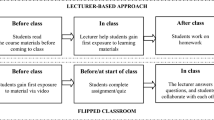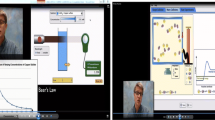Abstract
The present research aims to analyze the teaching processes of neurosciences to students of the professional career of primary education through the learning strategy called Flipped Classroom. The sample was of 52 university students (12 men (23.1%) and 40 women (76.9%). All the participants were in the fourth cycle of primary education studies at a private university in Lima—Peru. For 16 weeks, the participants studied the “Infant and Child Neuroscience” course, carried out practical activities and participated in entrance, process, and exit evaluations. The results showed that in the pre-test, the mean was 9.27 corresponding to the category “achievement at the beginning.” Then, in the process evaluation, the mean was 14.42, evidencing an “expected achievement.” And for the post-test, the mean was 11.67 corresponding to the category “achievement in process.”
Access this chapter
Tax calculation will be finalised at checkout
Purchases are for personal use only
Similar content being viewed by others
References
Araya-Pizarro S, Espinoza L (2020) Aportes desde las neurociencias para la comprensión de los procesos de aprendizaje en los contextos educativos. Propósitos y Representaciones 8(1):e312. https://doi.org/10.20511/pyr2020.v8n1.312
Marina J (2012) El diálogo entre la neurociencia y educación. Homepage, https://www.joseantoniomarina.net/articulo/neurociencia-y-educacion/. Last accessed 28 Dec 2020
Borck C (2016) How we may think. Imaging and writing technologies across the history of the neurosciences. Stud History Philos Sci C Stud History Philos Biol Biomed Sci 57:112–120. https://doi.org/10.1016/j.shpsc.2016.02.006
Gago L, Elgier Á (2018) Trazando puentes entre las neurociencias y la educación. Aportes, límites y caminos futuros en el campo educativo. Psicogente 21(40):476–494. https://doi.org/10.17081/psico.21.40.3087
Gazzaniga M (2002) Cognitive neuroscience. Norton & Co, Nueva York
Ortiz C (2008) Educación y formación de la personalidad. Fondo Editorial de la Universidad de Ciencias y Humanidades, Lima
Goswami U (2008) Principles of learning, implications for teaching: a cognitive neuroscience perspective. J Philos Educ 42:381–399. https://doi.org/10.1111/j.1467-9752.2008.00639.x
Martínez-Morga M, Martínez S (2016) Desarrollo y plasticidad del cerebro. Revista de Neurología 62(Supl 1):S3–S8
Garcés-Viera M, Suarez-Escudero J (2014) Neuroplasticidad: aspectos bioquímicos y neurofisiológicos. CES Medicine 28(1):119–132
Bowers J (2016) The practical and principled problems with Educational Neuroscience. Psychol Rev. https://doi.org/10.1037/rev0000025
Buxbaum J (2009) Multiple rare variants in the etiology of autism spectrum disorders. Dialogues Clin Neurosci 11:35–43
Morgado I (2012) Claves neurocientíficas de la enseñanza y el aprendizaje. Participación Educativa 1(1):15–17. Homepage, https://sede.educacion.gob.es/publiventa/descarga.action?f_codigo_agc=15796. Last accessed 15 Jan 2021
United Nations Educational Scientific Cultural Organization (2020) COVID-19 y educación superior: De los efectos inmediatos al día después Análisis de impactos, respuestas políticas y recomendaciones. Lima (2020). Homepage, http://www.iesalc.unesco.org/wp-content/uploads/2020/04/COVID-19-060420. Last accessed 12 Aug 2020
Bergmann J, Sams A, Cols S (2014) What is Flipped learning? Flipped learning network (FLN) (2014). Homepage, http://www.flippedlearning.org/cms/lib07/VA01923112/Centricity/Domain/46/FLIP_handout_FNL_Web.pdf. Last accessed 7 Jan 2020
Moodle.: Start building your online learning site in minutes (2021) Homepage, https://moodle.com/getstarted/. Last accessed 3 Feb 2021
Cáceres K (2020) Educación virtual: Creando espacios afectivos, de convivencia y aprendizaje en tiempos de COVID-19. Cienciamerica 9:3–7. https://doi.org/10.33210/ca.v9i2.284
Zoom.: Comprehensive Guide to Educating Through Zoom (2020) Homepage, https://www.zoom.us/docs/en-us/childrens-privacy.html. Last accessed 15 Jan 2021
Google.: Create attractive forms (2021) Homepage, https://www.google.com/intl/es-419_pe/forms/about/. 3 March 2021
Rustom A (2012) Estadística descriptiva, probabilidad e inferencia: Una visión conceptual y aplicada. Universidad de Chile, Santiago
Helsel D (2011) Statistics for consored environmental data using Minitab and R, 2nd edn. Wiley, Denver
Author information
Authors and Affiliations
Editor information
Editors and Affiliations
Rights and permissions
Copyright information
© 2022 The Author(s), under exclusive license to Springer Nature Singapore Pte Ltd.
About this paper
Cite this paper
Iraola-Real, I., Iraola-Real, E. (2022). Teaching Neuroscience Through Flipped Classroom: Systematizing an Experience with Students of the Professional Career of Elementary Education. In: Zhang, YD., Senjyu, T., So-In, C., Joshi, A. (eds) Smart Trends in Computing and Communications. Lecture Notes in Networks and Systems, vol 286. Springer, Singapore. https://doi.org/10.1007/978-981-16-4016-2_25
Download citation
DOI: https://doi.org/10.1007/978-981-16-4016-2_25
Published:
Publisher Name: Springer, Singapore
Print ISBN: 978-981-16-4015-5
Online ISBN: 978-981-16-4016-2
eBook Packages: Intelligent Technologies and RoboticsIntelligent Technologies and Robotics (R0)




